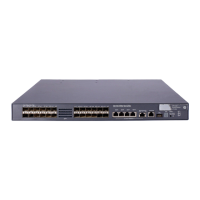157
[DeviceB-vlan3] quit
3. Verify the configuration
Use the display gvrp local-vlan command to display the local VLAN information maintained by GVRP on
ports. For example:
# Display the local VLAN information maintained by GVRP on port GigabitEthernet 1/0/1 of Device A.
[DeviceA] display gvrp local-vlan interface gigabitethernet 1/0/1
Following VLANs exist in GVRP local database:
1(default),2-3
According to the output, information about VLAN 1, static VLAN information of VLAN 2 on the local
device, and dynamic VLAN information of VLAN 3 on Device B are all registered through GVRP.
# Display the local VLAN information maintained by GVRP on port GigabitEthernet 1/0/1 of Device B.
[DeviceB] display gvrp local-vlan interface gigabitethernet 1/0/1
Following VLANs exist in GVRP local database:
1(default),2-3
According to the output, information about VLAN 1, static VLAN information of VLAN 3 on the local
device, and dynamic VLAN information of VLAN 2 on Device A are all registered through GVRP.
GVRP fixed registration mode configuration example
Network requirements
As shown in Figure 51,
• Device A and Device B are connected through their GigabitEthernet 1/0/1 ports.
• Enable GVRP and configure the fixed registration mode on ports to enable the registration and
deregistration of static VLAN information between the two devices.
Figure 51 Network diagram for GVRP fixed registration mode configuration
Configuration procedure
1. Configure Device A
# Enable GVRP globally.
<DeviceA> system-view
[DeviceA] gvrp
# Configure port GigabitEthernet 1/0/1 as a trunk port, and assign it to all VLANs.
[DeviceA] interface gigabitethernet 1/0/1
[DeviceA-GigabitEthernet1/0/1] port link-type trunk
[DeviceA-GigabitEthernet1/0/1] port trunk permit vlan all
# Enable GVRP on GigabitEthernet 1/0/1 and set the GVRP registration mode to fixed on the port.
[DeviceA-GigabitEthernet1/0/1] gvrp
[DeviceA-GigabitEthernet1/0/1] gvrp registration fixed
[DeviceA-GigabitEthernet1/0/1] quit
# Create VLAN 2 (a static VLAN).

